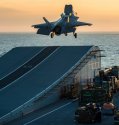Jura The idiot
General
I don't care about your acronyms (LOL those I leave to spin doctors):The difference between the £1.5bn and £1.65bn is the money wasted after Liam Fox ordered a review on catobar conversion and F-35C instead of F-35B. All because the F-35B was seen as a little shaky at the time.
Like I said the decision to slow the build is very well documented and was ordered by the Treasury to save £100m in year costs at the height of the GFC. It was very well documented at the time and the result of that decision as well.
£6.2 billion minus £1.5 = £4.7bn....
Which means I'm also being very generous at 1 ship costing £2.5bn as the programme cost included upgrades to dockyards, naval bases, onshore power supplies and onshore training facilities. The PoW is also being built significantly quicker which has an enormous effect on total costs. Quite frankly I'd be justified in having its price as closer to £2bn. But I thought I'd be very generous. If you don't understand Programme costs, IPA reported programmes or GMPP reporting it might be a little hard to grasp...
for me the cost of a ship is
money spent on her class
divided by
the number of ships in said class
Yesterday at 9:11 PM
6.2/2=3.1



